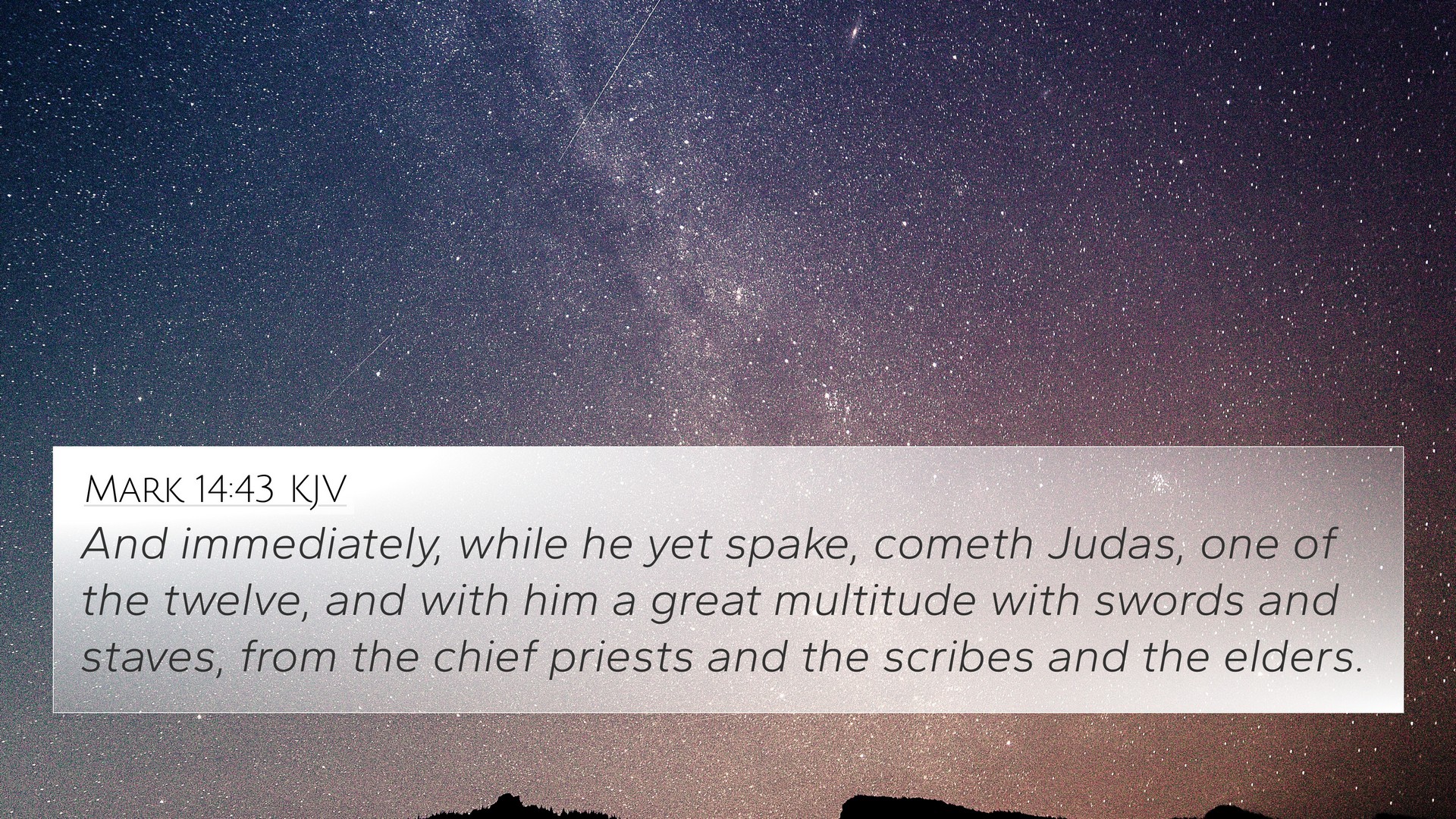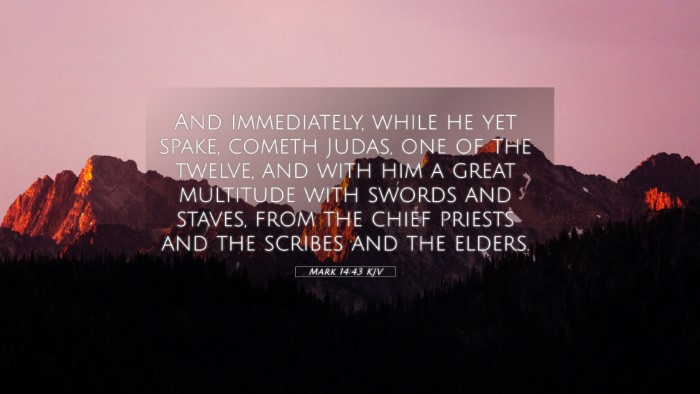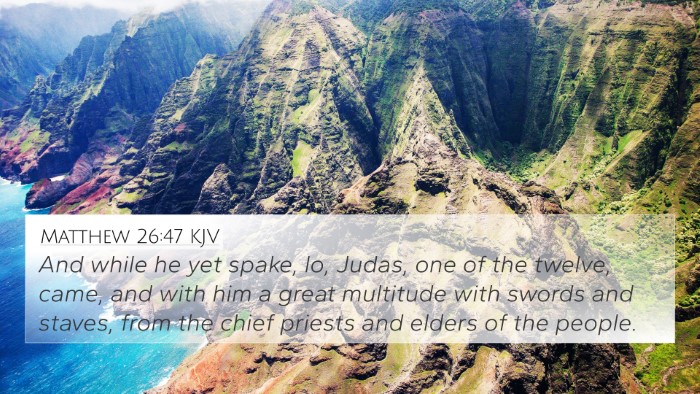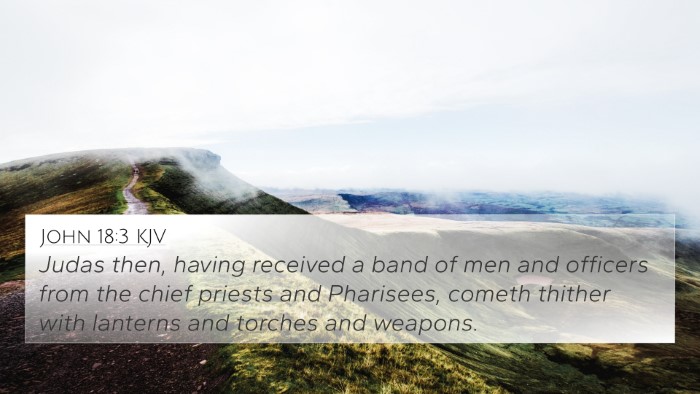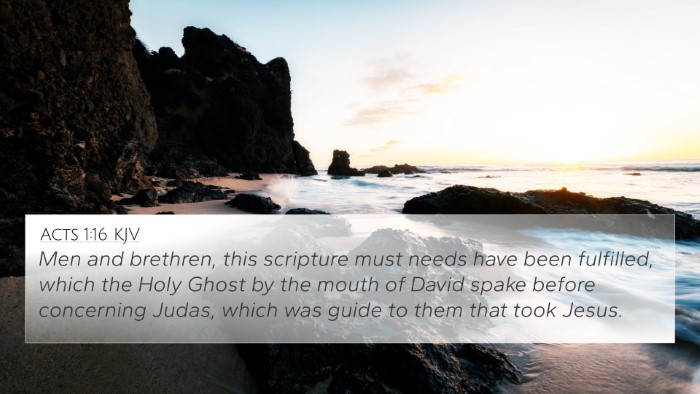Understanding Mark 14:43
Text: "And immediately, while he yet spake, cometh Judas, one of the twelve, and with him a great multitude with swords and staves, from the chief priests and the scribes and the elders."
Overview and Context
This verse falls within a critical moment during the passion narrative, where the tension culminates in the betrayal of Jesus by Judas Iscariot. The account is set in the Garden of Gethsemane, right before Jesus' arrest. The arrival of Judas, marked by the use of a 'great multitude,' signifies not only the betrayal but also the impending trial and crucifixion of Jesus, pivotal events in the Christian faith.
Commentary Insights
- Matthew Henry: Henry emphasizes the treachery of Judas, noting that he was one of the twelve apostles, which highlights the depth of his betrayal. He discusses the crowd's intentions and weapons, underlining that they came with the intent to overpower, demonstrating the spiritual conflict between light and darkness.
- Albert Barnes: Barnes reflects on the significant number of people who accompanied Judas, suggesting fear among the authorities regarding the influence of Jesus over the people. He notes this could indicate a lack of faith in their own power to apprehend Jesus without overwhelming force.
- Adam Clarke: Clarke connects this event to the prophecy of Zechariah 13:7, where the shepherd shall be smitten. He interprets the use of swords and staves as illustrative of human resistance to divine purpose and how Jesus, in this moment, becomes a target of worldly aggression.
Thematic Connections
This passage is intricately connected to various themes found throughout Scripture. To understand its depth, we can utilize various Bible verse cross-references to link verses that enrich our understanding:
- Matthew 26:47-49: A parallel account of Judas’ betrayal that provides deeper insights into his motivations.
- Luke 22:47-48: Another version of the betrayal, emphasizing Judas' role and the kiss as a sign of betrayal.
- John 18:3-5: Here, Jesus' demonstration of his power over the crowd increases the understanding of his divine authority even in his arrest.
- Zechariah 13:7: This prophetic reference ties the events surrounding Judas and his betrayal to the Old Testament.
- Psalm 41:9: It references the concept of betrayal by a close friend, which resonates deeply with Judas' actions.
- Matthew 5:10-12: Highlights the theme of persecution for righteousness, indirectly connecting to Jesus' impending suffering.
- Isaiah 53:3: This verse provides prophetic insight into Jesus being ‘despised and rejected,’ foreshadowing his treatment by Judas and the mob.
- Acts 1:16-20: Provides insight into the aftermath of Judas' betrayal and its implications for the disciples.
- Hebrews 12:2: Encourages believers to focus on Jesus in times of trial, reinforcing the need for faith amidst betrayal and darkness.
- 1 John 1:5-7: This text discusses the nature of light and darkness, which can be metaphorically connected to Judas' betrayal in a spiritual context.
Cross-Referencing Methodology
Utilizing tools for Bible cross-referencing enhances our comprehension of the narrative's significance. The method involves:
- Identifying Bible concordance entries that connect verses thematically.
- Engaging in cross-reference Bible study by drawing parallels between the Old and New Testament.
- Creating thematic maps that help visualize connections, such as Bible chain references.
Conclusion
Mark 14:43 serves as a vital juncture in the story of Jesus' passion, illustrating the depth of betrayal through Judas while setting the stage for the events leading to the crucifixion. By engaging with this verse through cross-referencing and thematic studies, deeper insights into the nature of faith, light versus darkness, and the human condition are revealed.
This comprehensive analysis encourages readers to explore connections between Bible verses, enhancing both personal study and sermon preparation.
